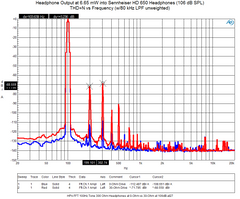Buy one component and save 10% on up to 2 cables. Buy 2 components and get 4 free cables. Free shipping on USA orders over $700. We will be closed on Good Friday (4/18/25).
Buy one component and save 10% on up to 2 cables. Buy 2 components and get 4 free cables. Free shipping on USA orders over $700. We will be closed on Good Friday (4/18/25).
The "0-Ohm" Headphone Amplifier
by John Siau December 01, 2001

The Sonic Advantages of Low-Impedance Headphone Amplifiers
- An introduction to "The 0-Ohm Headphone Amplifier" White Paper
The circuits used to drive headphones are often added to a product without careful consideration of the difficult loads presented by high-quality headphones. The most common circuit is an opamp driver followed by a 30-Ohm series resistor. The series resistor provides short-circuit and overload protection while isolating the opamp from the inductance and capacitance of the headphones. The series resistor protects the opamp while keeping it stable. In contrast, today's state-of-the-art headphone amplifiers eliminate the series resistor, and use a high current driver. This change reduces distortion and flattens the frequency response when a headphone is driven. These new high-end designs are often called "0-Ohm" headphone amplifiers, and are essentially miniature power amplifiers.
 This paper provides measurements which demonstrate the significant advantages of headphone amplifiers with very low (near 0-Ohm) output impedances. A low output impedance increases the damping factor of the amplifier-headphone system. This paper will show that a high damping factor reduces distortion at the headphone input, improves the phase response, and flattens the frequency response.
This paper provides measurements which demonstrate the significant advantages of headphone amplifiers with very low (near 0-Ohm) output impedances. A low output impedance increases the damping factor of the amplifier-headphone system. This paper will show that a high damping factor reduces distortion at the headphone input, improves the phase response, and flattens the frequency response.
Download the White Paper:
The "0"-Ohm Headphone Amplifier - John Siau
Additional reading:
More information on headphones and headphone amplifiers can be found here.
Also in Audio Application Notes

What is the Purpose of an FFT in Audio Measurements?
by Benchmark Media Systems May 05, 2025
The FFT … an Audio Microscope.
An FFT analyzer is like an audio microscope. It allows us to easily measure the frequency and amplitude of tones that are below the level of the noise. Traditional audio meters fail when the signal is lower than the noise level, but with an FFT, we can accurately measure tones that are 30 to 40 dB below the level of the noise.
In many ways, our ears behave like an FFT audio measurement system. Our ears can detect the frequency and amplitude of tones that are as much as 30 dB below the ambient noise. This means that our ears are 30 dB better than traditional audio meters! This is why we can carry on a conversation in a noisy room, and this is why we can hear individual instruments within an orchestra. This is also why small defects need to be detected and corrected when designing top-quality audio gear.
John Siau, Benchmark’s lead Engineer, will explain the “magic” of the FFT analyzer without the use of advanced mathematics. He will show an FFT analyzer in action, and he will measure a complete Benchmark chain to determine if it produces audible noise or distortion. Learn how to read an FFT plot and learn what to look for when selecting audio components.

Interpolator Overload Distortion
by Benchmark Media Systems November 20, 2024
Most digital playback devices include digital interpolators. These interpolators increase the sample rate of the incoming audio to improve the performance of the playback system. Interpolators are essential in oversampled sigma-delta D/A converters, and in sample rate converters. In general, interpolators have vastly improved the performance of audio D/A converters by eliminating the need for analog brick wall filters. Nevertheless, digital interpolators have brick wall digital filters that can produce unique distortion signatures when they are overloaded.
10% Distortion
An interpolator that performs wonderfully when tested with standard test tones, may overload severely when playing the inter-sample musical peaks that are captured on a typical CD. In our tests, we observed THD+N levels exceeding 10% while interpolator overloads were occurring. The highest levels were produced by devices that included ASRC sample rate converters.

Audiophile Snake Oil
by John Siau April 05, 2024
The Audiophile Wild West
Audiophiles live in the wild west. $495 will buy an "audiophile fuse" to replace the $1 generic fuse that came in your audio amplifier. $10,000 will buy a set of "audiophile speaker cables" to replace the $20 wires you purchased at the local hardware store. We are told that these $10,000 cables can be improved if we add a set of $300 "cable elevators" to dampen vibrations. You didn't even know that you needed elevators! And let's not forget to budget at least $200 for each of the "isolation platforms" we will need under our electronic components. Furthermore, it seems that any so-called "audiophile power cord" that costs less than $100, does not belong in a high-end system. And, if cost is no object, there are premium versions of each that can be purchased by the most discerning customers. A top-of-the line power cord could run $5000. One magazine claims that "the majority of listeners were able to hear the difference between a $5 power cable and a $5,000 power cord". Can you hear the difference? If not, are you really an audiophile?

